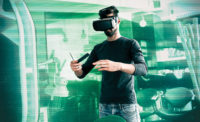Researchers at Shenandoah University believe that virtual reality is the forefront of education, not just for traditional schools, but also for training first responders.
The Shenandoah Center for Immersive Learning (SCIL) created three simulations to present to first responders at the Emergency Preparedness Instructional Center's public safety open house. The free event drew over 20 first responders and educators to Shenandoah's Halpin-Harrison Hall.
The Emergency Preparedness Instructional Center (EPIC), an offshoot of SCIL, has only been formally active since January, but EPIC Director Matthew Watson says they've created a tool that could change the way law enforcement and fire and rescue teams train their personnel.
"The idea is now we can put someone in a very immersive environment to where it seems so real and we get the same stress response," said Watson. "Mentally, I've already experienced this. So when I actually have to deal with it in the real world, I'm much more prepared."
The trainings vary and each has its own purpose. One simulation allows the user to examine the human body, getting up close and personal with organs that they need to be able to identify. Users can see a set of lungs, comparing healthy tissue to that of a patient with asthma or chronic obstructive pulmonary disease.
Another type of training puts the participant in the middle of a classroom in Handley High School in Winchester, Va., where they watch as students and teachers cower as a school shooter roams the halls. The creators hope it can give first responders an idea of how scared and traumatized students will be.
A third virtual reality training session is a two part process. Initially, it's a crisis intervention. Participants speak with an actor, role playing a character who may have dementia, autism, or experiencing suicidal ideations. That exchange is captured by a 360 degree camera.
"Later in the day, they can step into VR and they can see how they interact with the individual so they can self-assess their behavior," said SCIL Director J.J. Ruscella. In practice, this would give the user the opportunity to critique their body language and that of the individual, and perhaps see where things go wrong.
Organizers hope to get this technology into the hands of first responders everywhere. Attendees who haven't used it before seemed open to it.
Director of Homeland Security and Emergency Management in Morgan County, W. Va. dove into the human body and examined the inside of a pair of lungs. He hadn't used virtual reality before and referred to is as feeling like a video game.
"I was nervous a little bit at first, but I'm into it now," he laughed.
Source: www.localdvm.com



